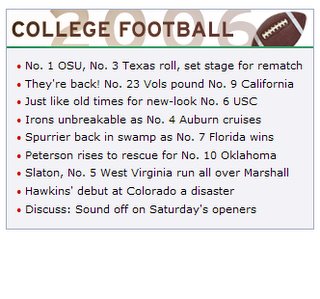Willie Parker's Night
As of last night, the first NFL game is in the gamebooks and Willie Parker is right now the NFL's leading rusher, finishing the night with 115 yards on 29 carries. Those numbers don't tell the whole story of his night so let's look beneath them a little bit. Overall, he gained a successful amount of yardage on 12 of those runs for a success rate of 41.3%. Nineteen of his runs were up the middle or off-guard, seven were around the left end, two were around the right end, one was off the left tackle, and he did not run right tackle at all during the game.
The first half was the worse half for the Pittsburgh running game even though Parker ended up with a higher yards per carry than he had in the second half (4.4 to 3.6). Really the only reason the yards per carry average was that high was because of his 32-yard run off right end. Take that run away and Parker only had 2.1 yards per carry in the first half. This low average is reflected in the fact he only had four successful runs out of thirteen rushes, two out of 8 on runs up the middle.
It was the second half where Parker and the Steelers got on track in their running game with Parker having successful runs on eight of his sixteen carries with the successful yardage being more evenly distributed. His most marked improvement came on runs up the middle where he had five successful runs on eleven carries, which is very important since Pittsburgh prides itself most on the ability to run up the middle. Had Parker continued to fail in these runs, perhaps there would have been another victor in this game.
*Successful running plays are defined as 40% of yardage on first down, 60% on second down, and 100% on third or fourth down. When the running back's team has a lead in the first quarter, it's 30% on first down, 50% on second down, and the same for third or fourth downs.
The first half was the worse half for the Pittsburgh running game even though Parker ended up with a higher yards per carry than he had in the second half (4.4 to 3.6). Really the only reason the yards per carry average was that high was because of his 32-yard run off right end. Take that run away and Parker only had 2.1 yards per carry in the first half. This low average is reflected in the fact he only had four successful runs out of thirteen rushes, two out of 8 on runs up the middle.
It was the second half where Parker and the Steelers got on track in their running game with Parker having successful runs on eight of his sixteen carries with the successful yardage being more evenly distributed. His most marked improvement came on runs up the middle where he had five successful runs on eleven carries, which is very important since Pittsburgh prides itself most on the ability to run up the middle. Had Parker continued to fail in these runs, perhaps there would have been another victor in this game.
*Successful running plays are defined as 40% of yardage on first down, 60% on second down, and 100% on third or fourth down. When the running back's team has a lead in the first quarter, it's 30% on first down, 50% on second down, and the same for third or fourth downs.



